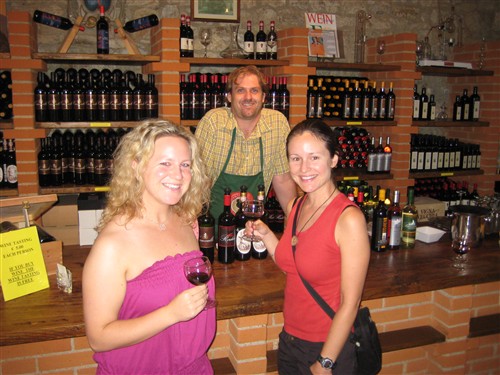
After a schizophrenic four days of trying to see everything in Rome, we picked up a car and set out early for Tuscany. Having had difficulty navigating the cities in France, we had asked Natty to buy the Italy software for her Garmin and bring it along. With our frenetic pace in Rome, we had failed to MapQuest the driving directions as a backup and instead put our faith in the Garmin. Big mistake! For whatever reason, it had major difficulty picking up the satellites in Rome and also outside the cities. To complicate matters, our accommodation was located in the countryside about 15 kms outside of Siena on winding, nondescript gravel roads. In short, what should have been a two hour drive took more like five hours, with each of us cursing the Garmin at regular intervals. The saving grace for our frayed nerves was the stunning view of the Tuscan hills in every direction.
We finally reached Castello di Selvole on a gorgeous hilltop vineyard property and were greeted warmly by the receptionist who gave us recommendations, excellent maps and the key to an adorable stone house with magnificent views. The place was so perfect that I squealed at the sight of it. It had a thoughtfully stocked kitchen, a large elevated patio, and a pool. The house had so much warmth and character that we all felt right at home.
With a few hours of daylight remaining, we hopped back into the car and drove to Siena to buy groceries and wine for a sunset dinner on our patio. Enveloped in the patchwork quilt of the vibrant wine country, we sipped our wine, talked quietly over steaming plates of pasta, and let the chaos of the day melt away.
The next morning, we lingered over breakfast on the patio. I had made a colossal error by setting out a bowl of milk for the two vineyard wild cats that had appeared on our doorstep the first night, and now the little bastards were relentless – stalking and hissing at us. We spent the next two days chasing them off with brooms. Our plan was to spend the first half of the day tooling around Siena and the second half wine tasting in Chianti.
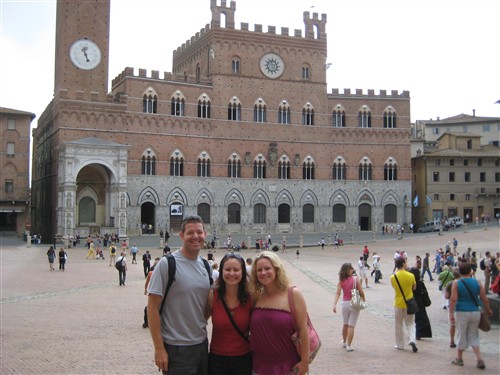 Siena flourished in the medieval period, as evidenced by its enduring Gothic architecture and narrow stone streets. Auto traffic has been banished from the town center, making for pleasant pedestrian walkways and a frustrating time for tourists with cars. We managed to find our way into one of the parking garages just inside the medieval city walls and walked uphill into the historic town center – the sloping, bricked Piazza del Campo. Il Campo, as it is also called, is Siena’s social center. The extraordinarily large piazza, surrounded by museums, shops and ubiquitous outdoor cafés, is a pleasant spot for a rest, despite the throngs of tourists (mostly Americans) who pour into it like herds of cattle. Italy is overflowing with tourists and we have encountered more American tourists in Italy than anywhere else in the world.
Siena flourished in the medieval period, as evidenced by its enduring Gothic architecture and narrow stone streets. Auto traffic has been banished from the town center, making for pleasant pedestrian walkways and a frustrating time for tourists with cars. We managed to find our way into one of the parking garages just inside the medieval city walls and walked uphill into the historic town center – the sloping, bricked Piazza del Campo. Il Campo, as it is also called, is Siena’s social center. The extraordinarily large piazza, surrounded by museums, shops and ubiquitous outdoor cafés, is a pleasant spot for a rest, despite the throngs of tourists (mostly Americans) who pour into it like herds of cattle. Italy is overflowing with tourists and we have encountered more American tourists in Italy than anywhere else in the world.
We had vowed to refrain from Siena’s tempting museums to save our stamina for Florence. However, when we saw the magnificent façade of Siena’s Gothic Cathedral with its intricate designs in white pink and green polychrome marble, we had to go inside. The interior was striking with thick black-and-white striped columns reaching up to the tall vaulted ceilings. Natalie aptly described it as the “Beetlejuice Church”, its stripes resembling old style prison garb and seeming eerily comical. The cathedral’s most notable feature was the marble inlaid floor with a series of historical and Biblical scenes: chilling depictions of religious persecution – beheadings, knights tearing babies from their pleading mothers’ grasps. The cathedral visit was an intensely satisfying experience and well worth the price of admission.
Pleased with our Siena endeavors, we set off for wine tasting, heading toward the tiny town of Radda in Chianti with a full itinerary of wineries that I had hastily mapped in advance. The drive through Tuscany’s rolling golden hills, punctuated with vineyards, olive groves, cypress trees, and old stone villas enchanted us all. The leaves on the trees were just beginning to change, adding the colors of fall to the already gorgeous palate of red, green and gold.
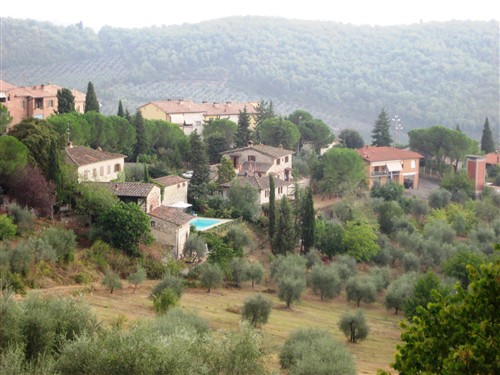 The Chianti region, also called Chiantishire, is divided into two sub regions – Chianti Sienese, and Chianti Florentine. Within the region are pretty little stone towns and surrounding the towns are the wineries. As it was already midafternoon, we chose a handful of wineries solely for their geographical location; we knew nothing about any of them. After our frustrating wine tasting experience in Bordeaux, I sent up a silent prayer that the Tuscan winemakers would be a bit more hospitable than the French. The Big Man delivered.
The Chianti region, also called Chiantishire, is divided into two sub regions – Chianti Sienese, and Chianti Florentine. Within the region are pretty little stone towns and surrounding the towns are the wineries. As it was already midafternoon, we chose a handful of wineries solely for their geographical location; we knew nothing about any of them. After our frustrating wine tasting experience in Bordeaux, I sent up a silent prayer that the Tuscan winemakers would be a bit more hospitable than the French. The Big Man delivered.
At our first stop, a winery called Vignavecchia, we had a fabulous tasting with a burly, friendly steward. He poured us a generous selection of whites and reds, all of which we loved. We bought a bottle of his Chianti Classico and went merrily on our way, off to a fantastic start! Chianti Classico is the region’s premium wine. Within the Chianti region, a sub-region has been cut out and designated as Chianti Classico. In order for a wine to be labeled as Chianti Classico, it must be made of at least 80% Sangiovese grapes from within the Chianti Classico sub-region.
Next, we pulled into a property called Monteraponi down a winding gravel road. We approached to find a cluster of old stone buildings that all looked dark and closed. We poked around for a few moments before heading for the car. I had seen a man and woman lounging on a secluded sunken patio but they didn’t say anything when we’d first passed by and I took the place for a private family property but, as we passed by again, the woman climbed halfway up the stairs and with a funny smile, said “Vino?” “Yes, please!” we replied and she yelled down the stairs to her husband – a middle-aged man relaxing in his wife-beater on a Saturday afternoon – to go get the wine. He slowly made a move while she gestured us toward the cluster of buildings. There were quaint houses that looked like guest cottages and we wandered around the property, taking photos while we waited for the wine to appear. Eventually the husband re-surfaced, carrying a single wine bottle. Aaron and I exchanged suspicious glances. The man handed off the bottle to his wife – a hefty, slightly masculine woman with short dark hair and a kind face – who led us into a small office at the property entrance. Neither of them spoke a word of English which we found both awkward and charmingly authentic.
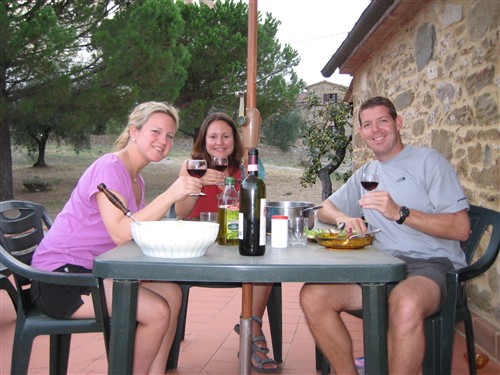 Inside the office, the woman set out three glasses on a desktop, opened a bottle of wine slowly and poured. It is always a bit nerve-racking at the tiny wineries where you’re the only ones there and the family owners conduct a tasting just for you. You know you’ll end up buying a bottle out of obligation and you pray that it’s halfway decent and not too expensive. We each took a sip and smiles spread across our faces. It was fabulous! We happily bought a bottle and then one more of her more expensive vintage which she offered to open for us to taste but we declined, not wanting her to open another for just one taste. It turned out to be the best bottle in our booty from Chianti – and it was a big booty! In a matter of a few hours, we had filled the back seat of our crappy blue Fiat Punto with wine bottles from four different wineries and were on our way back to our wonderful house at Castello di Selvole. It was a damp, chilly night so we cooked another decadent Italian feast and devoured it with our bottle Monteraponi Chianti Classico Riserva “Il Campitello” D.O.C.G. in the warmth of our cozy kitchen.
Inside the office, the woman set out three glasses on a desktop, opened a bottle of wine slowly and poured. It is always a bit nerve-racking at the tiny wineries where you’re the only ones there and the family owners conduct a tasting just for you. You know you’ll end up buying a bottle out of obligation and you pray that it’s halfway decent and not too expensive. We each took a sip and smiles spread across our faces. It was fabulous! We happily bought a bottle and then one more of her more expensive vintage which she offered to open for us to taste but we declined, not wanting her to open another for just one taste. It turned out to be the best bottle in our booty from Chianti – and it was a big booty! In a matter of a few hours, we had filled the back seat of our crappy blue Fiat Punto with wine bottles from four different wineries and were on our way back to our wonderful house at Castello di Selvole. It was a damp, chilly night so we cooked another decadent Italian feast and devoured it with our bottle Monteraponi Chianti Classico Riserva “Il Campitello” D.O.C.G. in the warmth of our cozy kitchen.
Our visit to Siena, our stay in the old stone house in the country, and our wine tasting in Chianti were among the best experiences that Aaron and I have had on our entire trip. We were bowled over by the beauty of Tuscany’s picturesque hills and valleys and by the amazing Chianti wines. Our wine horizons have once again been expanded to include some of the juiciest reds our California Cab-soaked palates have ever tasted. For the gorgeous scenery, the magnificent wine, and the happy, warm, welcoming hospitality of the Chianti winemakers, I say to Tuscany, “Cheers!” It was simply a pleasure!

 Next, we walked a scenic, one-kilometer trail, called Lovers Lane, between Manarola and the easternmost village of Riomaggiore, browsed around town for a while at the focaccerias and ceramic shops, and snapped countless shots of the photogenic villagescape before hopping a train to the westernmost village of Monterosso. Monterosso has the longest stretch of beach of all five villages and the ocean was beckoning us for a swim. Of the utmost importance, however, was finding Focacceria Enoteca Antonia which reportedly served fifteen kinds of focaccia from scratch. Our stomachs were rumbling and our mouths watering before we reached the doorway just across from the beach. All four varieties of piping hot, generously topped focaccia were unbelievably delicious, making it hard to refrain from stuffing ourselves silly. After that, I felt wholeheartedly that my Cinque Terre experience was complete.
Next, we walked a scenic, one-kilometer trail, called Lovers Lane, between Manarola and the easternmost village of Riomaggiore, browsed around town for a while at the focaccerias and ceramic shops, and snapped countless shots of the photogenic villagescape before hopping a train to the westernmost village of Monterosso. Monterosso has the longest stretch of beach of all five villages and the ocean was beckoning us for a swim. Of the utmost importance, however, was finding Focacceria Enoteca Antonia which reportedly served fifteen kinds of focaccia from scratch. Our stomachs were rumbling and our mouths watering before we reached the doorway just across from the beach. All four varieties of piping hot, generously topped focaccia were unbelievably delicious, making it hard to refrain from stuffing ourselves silly. After that, I felt wholeheartedly that my Cinque Terre experience was complete.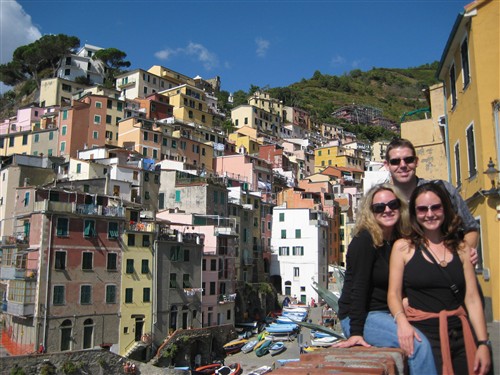 Leaving Cinque Terre was like losing touch with a good friend. You find happiness in other things but every now and then, when your mind stops spinning with the day’s distractions, your friend’s face flashes through your mind and warms you with fond memories. I hope someday to return to Cinque Terre, to wander the colorful streets of Manarola, to swim in the sea at Monterosso, and to explore the villages that we missed this time. In the meantime, I’ll rejoice in the quiet moments when my mind is free to swim with happy memories of a very special place.
Leaving Cinque Terre was like losing touch with a good friend. You find happiness in other things but every now and then, when your mind stops spinning with the day’s distractions, your friend’s face flashes through your mind and warms you with fond memories. I hope someday to return to Cinque Terre, to wander the colorful streets of Manarola, to swim in the sea at Monterosso, and to explore the villages that we missed this time. In the meantime, I’ll rejoice in the quiet moments when my mind is free to swim with happy memories of a very special place.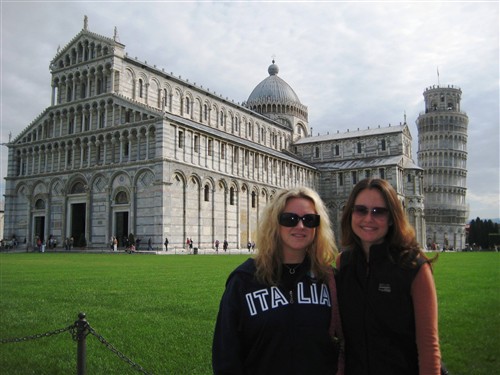
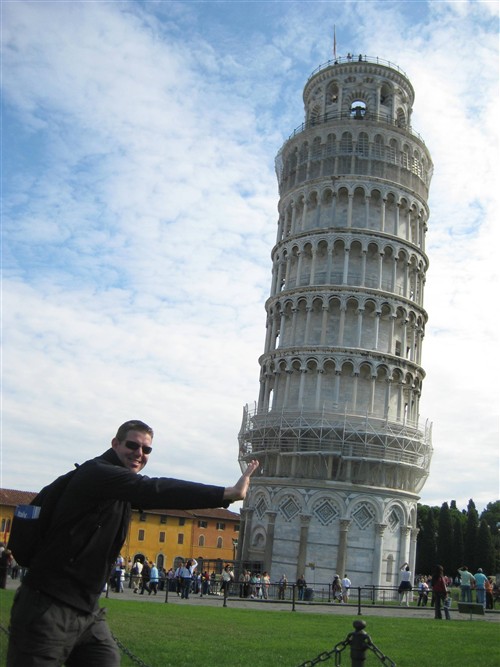 The Leaning Tower, which was designed as a bell tower for the Cathedral, began to lean even before it was completed. Shifting soil is the most widely suspected cause. In 1998, the ever-increasing lean was halted to 4.1 meters and successfully reinforced.
The Leaning Tower, which was designed as a bell tower for the Cathedral, began to lean even before it was completed. Shifting soil is the most widely suspected cause. In 1998, the ever-increasing lean was halted to 4.1 meters and successfully reinforced.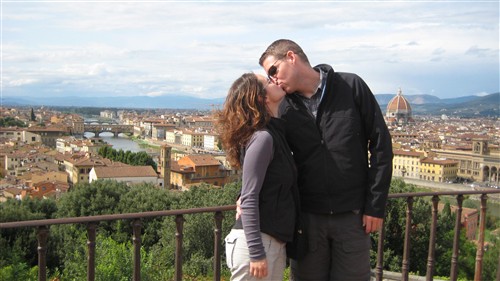
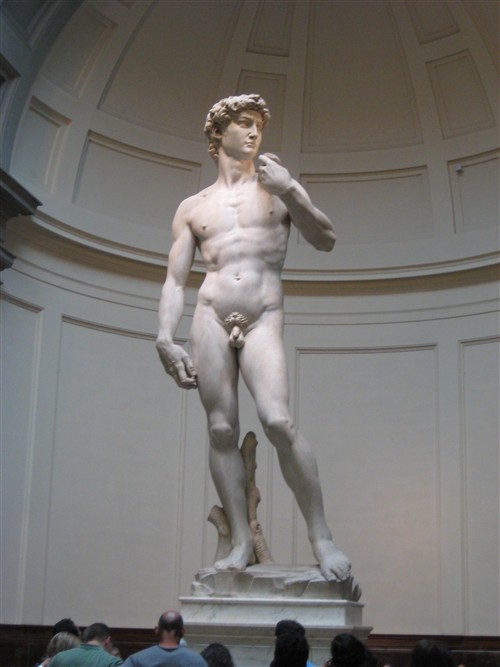 David, standing 5.16 meters tall in pearly white marble, bathed in perfect soft light, muscles tensed, with a mane like Adonis, is a vision of jaw-dropping perfection of the male form. I had seen countless photos of him and still he was more beautiful than I imagined. He is so striking that you cannot take your eyes off him; you can only stare at him in total awe. There were rooms of oil paintings surrounding him but I could not concentrate on them – I kept coming back to David. Soon I gave up on the idea of seeing anything else and took a seat, letting my mind envelope David completely. He was so magnificent that it almost hurt to look at him because you knew that eventually you would have to leave him. I realize that it sounds silly, this instantaneous obsession with an exquisitely carved piece of marble, but it wasn’t just me and it wasn’t just the women who fell in love at first sight. The men were equally smitten with David’s beauty and unabashed in expressing their admiration, which is likely due to his nonthreatening, aesthetically pleasing, classically small penis. In any case, we were all heartbroken when the time came for our inevitable departure and, even as I write this now, I feel the pain of loss and the hope that I will see him again.
David, standing 5.16 meters tall in pearly white marble, bathed in perfect soft light, muscles tensed, with a mane like Adonis, is a vision of jaw-dropping perfection of the male form. I had seen countless photos of him and still he was more beautiful than I imagined. He is so striking that you cannot take your eyes off him; you can only stare at him in total awe. There were rooms of oil paintings surrounding him but I could not concentrate on them – I kept coming back to David. Soon I gave up on the idea of seeing anything else and took a seat, letting my mind envelope David completely. He was so magnificent that it almost hurt to look at him because you knew that eventually you would have to leave him. I realize that it sounds silly, this instantaneous obsession with an exquisitely carved piece of marble, but it wasn’t just me and it wasn’t just the women who fell in love at first sight. The men were equally smitten with David’s beauty and unabashed in expressing their admiration, which is likely due to his nonthreatening, aesthetically pleasing, classically small penis. In any case, we were all heartbroken when the time came for our inevitable departure and, even as I write this now, I feel the pain of loss and the hope that I will see him again.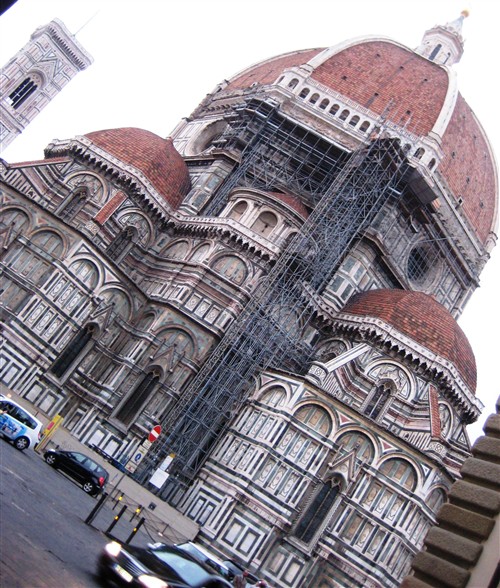 We attended a decidedly uninspiring Catholic mass at the Duomo, mostly because it happened to be starting when we arrived and because we thought the service would be beautiful. It was the Duomo after all! Disappointingly, there was no music and the sermon was so dry and monotone that we struggled to stay awake. We said our prayers and silently missed our wonderful church in Fort Worth, where our dear Father Michael Stearns delivered moving and memorable sermons that made us eagerly anticipate Sunday services.
We attended a decidedly uninspiring Catholic mass at the Duomo, mostly because it happened to be starting when we arrived and because we thought the service would be beautiful. It was the Duomo after all! Disappointingly, there was no music and the sermon was so dry and monotone that we struggled to stay awake. We said our prayers and silently missed our wonderful church in Fort Worth, where our dear Father Michael Stearns delivered moving and memorable sermons that made us eagerly anticipate Sunday services. The best thing about Florence however, besides David, is just being in Florence. The neighborhoods are beautiful to walk through with their colorful weathered buildings and pretty café-lined piazzas. A walk along the Arno River that runs through the city affords some of the best views, especially around the Ponte Vecchio – a picturesque bridge with small jewelry shops lining both sides all the way across. But you haven’t seen Florence until you’ve seen it from Piazzale Michelangelo on one of the many hills that surround the city. Only from an elevated position can you take in the sea of red rooftops punctuated by the Duomo and the dreamy Arno, its small bridges reflecting on the lazy river’s glassy surface. We spent over an hour just looking across the cityscape.
The best thing about Florence however, besides David, is just being in Florence. The neighborhoods are beautiful to walk through with their colorful weathered buildings and pretty café-lined piazzas. A walk along the Arno River that runs through the city affords some of the best views, especially around the Ponte Vecchio – a picturesque bridge with small jewelry shops lining both sides all the way across. But you haven’t seen Florence until you’ve seen it from Piazzale Michelangelo on one of the many hills that surround the city. Only from an elevated position can you take in the sea of red rooftops punctuated by the Duomo and the dreamy Arno, its small bridges reflecting on the lazy river’s glassy surface. We spent over an hour just looking across the cityscape.
 Siena flourished in the medieval period, as evidenced by its enduring Gothic architecture and narrow stone streets. Auto traffic has been banished from the town center, making for pleasant pedestrian walkways and a frustrating time for tourists with cars. We managed to find our way into one of the parking garages just inside the medieval city walls and walked uphill into the historic town center – the sloping, bricked Piazza del Campo. Il Campo, as it is also called, is Siena’s social center. The extraordinarily large piazza, surrounded by museums, shops and ubiquitous outdoor cafés, is a pleasant spot for a rest, despite the throngs of tourists (mostly Americans) who pour into it like herds of cattle. Italy is overflowing with tourists and we have encountered more American tourists in Italy than anywhere else in the world.
Siena flourished in the medieval period, as evidenced by its enduring Gothic architecture and narrow stone streets. Auto traffic has been banished from the town center, making for pleasant pedestrian walkways and a frustrating time for tourists with cars. We managed to find our way into one of the parking garages just inside the medieval city walls and walked uphill into the historic town center – the sloping, bricked Piazza del Campo. Il Campo, as it is also called, is Siena’s social center. The extraordinarily large piazza, surrounded by museums, shops and ubiquitous outdoor cafés, is a pleasant spot for a rest, despite the throngs of tourists (mostly Americans) who pour into it like herds of cattle. Italy is overflowing with tourists and we have encountered more American tourists in Italy than anywhere else in the world. The Chianti region, also called Chiantishire, is divided into two sub regions – Chianti Sienese, and Chianti Florentine. Within the region are pretty little stone towns and surrounding the towns are the wineries. As it was already midafternoon, we chose a handful of wineries solely for their geographical location; we knew nothing about any of them. After our frustrating wine tasting experience in Bordeaux, I sent up a silent prayer that the Tuscan winemakers would be a bit more hospitable than the French. The Big Man delivered.
The Chianti region, also called Chiantishire, is divided into two sub regions – Chianti Sienese, and Chianti Florentine. Within the region are pretty little stone towns and surrounding the towns are the wineries. As it was already midafternoon, we chose a handful of wineries solely for their geographical location; we knew nothing about any of them. After our frustrating wine tasting experience in Bordeaux, I sent up a silent prayer that the Tuscan winemakers would be a bit more hospitable than the French. The Big Man delivered. Inside the office, the woman set out three glasses on a desktop, opened a bottle of wine slowly and poured. It is always a bit nerve-racking at the tiny wineries where you’re the only ones there and the family owners conduct a tasting just for you. You know you’ll end up buying a bottle out of obligation and you pray that it’s halfway decent and not too expensive. We each took a sip and smiles spread across our faces. It was fabulous! We happily bought a bottle and then one more of her more expensive vintage which she offered to open for us to taste but we declined, not wanting her to open another for just one taste. It turned out to be the best bottle in our booty from Chianti – and it was a big booty! In a matter of a few hours, we had filled the back seat of our crappy blue Fiat Punto with wine bottles from four different wineries and were on our way back to our wonderful house at Castello di Selvole. It was a damp, chilly night so we cooked another decadent Italian feast and devoured it with our bottle Monteraponi Chianti Classico Riserva “Il Campitello” D.O.C.G. in the warmth of our cozy kitchen.
Inside the office, the woman set out three glasses on a desktop, opened a bottle of wine slowly and poured. It is always a bit nerve-racking at the tiny wineries where you’re the only ones there and the family owners conduct a tasting just for you. You know you’ll end up buying a bottle out of obligation and you pray that it’s halfway decent and not too expensive. We each took a sip and smiles spread across our faces. It was fabulous! We happily bought a bottle and then one more of her more expensive vintage which she offered to open for us to taste but we declined, not wanting her to open another for just one taste. It turned out to be the best bottle in our booty from Chianti – and it was a big booty! In a matter of a few hours, we had filled the back seat of our crappy blue Fiat Punto with wine bottles from four different wineries and were on our way back to our wonderful house at Castello di Selvole. It was a damp, chilly night so we cooked another decadent Italian feast and devoured it with our bottle Monteraponi Chianti Classico Riserva “Il Campitello” D.O.C.G. in the warmth of our cozy kitchen.
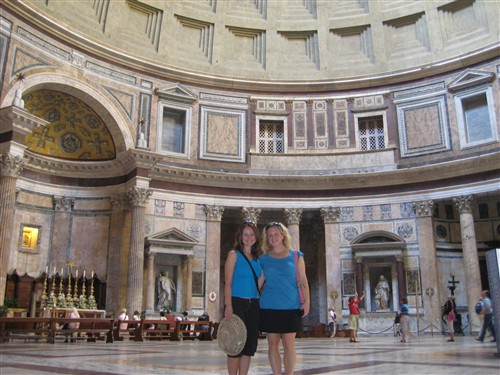 From the outside, it looks nothing like a church and much like a government building. Only after stepping inside do you begin to appreciate its architectural significance. The Pantheon is topped by the largest stone vault ever built – a perfect semisphere, meaning that the diameter (43.4 meters) of the dome is exactly equal to the height. There are no windows. The only natural light enters through a hole at the top of the dome and through the entrance when the tall bronze doors are open. The interior furnishings and embellishment are muted in comparison to other Christian buildings in Rome and elsewhere, with only a few marble sculptures and sparse iconography. Even the altar is decorated simply. The multi-hued stone and the vastness of the dome speak for the Pantheon’s magnificent beauty.
From the outside, it looks nothing like a church and much like a government building. Only after stepping inside do you begin to appreciate its architectural significance. The Pantheon is topped by the largest stone vault ever built – a perfect semisphere, meaning that the diameter (43.4 meters) of the dome is exactly equal to the height. There are no windows. The only natural light enters through a hole at the top of the dome and through the entrance when the tall bronze doors are open. The interior furnishings and embellishment are muted in comparison to other Christian buildings in Rome and elsewhere, with only a few marble sculptures and sparse iconography. Even the altar is decorated simply. The multi-hued stone and the vastness of the dome speak for the Pantheon’s magnificent beauty.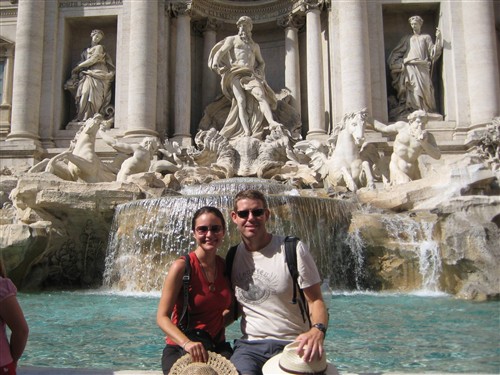 Rome is famous for its dreamy piazzas – open squares tucked into the city, often with a central fountain, coming alive on moonlit evenings. The Trevi Fountain – Rome’s most famous – is the focal point of one such piazza. “The baroque bonanza was designed by Nicola Salvi in 1732 and depicts Neptune’s chariot being led by Tritons with sea horses – one wild, one docile – representing the various moods of the sea.” (Lonely Planet, Feb 2008) The piazza was full of people snapping photos, enjoying cones of gelato, or just staring at the Trevi’s mesmerizing dance in its pool of aquamarine.
Rome is famous for its dreamy piazzas – open squares tucked into the city, often with a central fountain, coming alive on moonlit evenings. The Trevi Fountain – Rome’s most famous – is the focal point of one such piazza. “The baroque bonanza was designed by Nicola Salvi in 1732 and depicts Neptune’s chariot being led by Tritons with sea horses – one wild, one docile – representing the various moods of the sea.” (Lonely Planet, Feb 2008) The piazza was full of people snapping photos, enjoying cones of gelato, or just staring at the Trevi’s mesmerizing dance in its pool of aquamarine.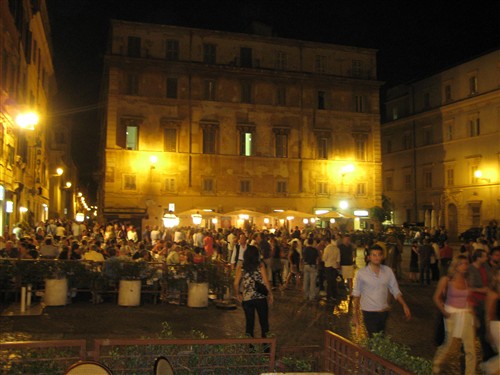
 The final stop that I want to mention is the Chiesa di Santa Maria della Concezione – a small, nondescript 17th century church near Piazza Barberini. What makes it one of the most fascinating stops on the tourist trail is the crypt which is decorated with the bones of 4,000 departed monks. We knew going in what we were going to see and still our jaws dropped at the sight of it. The crypt consists of five or six small rooms with dirt floors, each with an elaborate and mesmerizing display. Bones are used to make chandeliers, picture frames, flower patterns and a clock, among many other designs. Some of the skeletons are posed intact, dressed in the brown monks’ robes; some of the faces still have traces of flesh which has yet to decompose. The displays are eerily fascinating. Four thousand monks yield a lot of bones! Stacks of hundreds of femurs, tibias and fibulas line the walls in artistic forms. Hip bones become angel wings under smiling skulls. To see a sense of humor in the designs is both shocking and refreshing. In the last room along the hall, the collective epitaph of the monks is written on a small board: “What you are now we used to be; what we are now you will be.”
The final stop that I want to mention is the Chiesa di Santa Maria della Concezione – a small, nondescript 17th century church near Piazza Barberini. What makes it one of the most fascinating stops on the tourist trail is the crypt which is decorated with the bones of 4,000 departed monks. We knew going in what we were going to see and still our jaws dropped at the sight of it. The crypt consists of five or six small rooms with dirt floors, each with an elaborate and mesmerizing display. Bones are used to make chandeliers, picture frames, flower patterns and a clock, among many other designs. Some of the skeletons are posed intact, dressed in the brown monks’ robes; some of the faces still have traces of flesh which has yet to decompose. The displays are eerily fascinating. Four thousand monks yield a lot of bones! Stacks of hundreds of femurs, tibias and fibulas line the walls in artistic forms. Hip bones become angel wings under smiling skulls. To see a sense of humor in the designs is both shocking and refreshing. In the last room along the hall, the collective epitaph of the monks is written on a small board: “What you are now we used to be; what we are now you will be.”